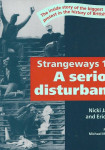‘It went off in the chapel on the morning of April Fools’ Day, 1990. It was no joke though. There were serious grievances at Strangeways.’
At the time, however, most prisoners, if they thought about it at all, thought they would be in the chapel for a few hours, attract some attention, maybe win on a few of the points, undoubtedly lose a little remission. Nobody had any idea of the scale of the events which would unfold.
These are the opening words of Strangeways 1990: a serious disturbance, published in 1995. Nicki Jameson and Eric Allison are credited as the authors, but it is not our story; it is that of the prisoners who took to the roof that April day and held on to it, in dwindling numbers, until the last magic moment on 25 April when:
At 6.20pm the final five prisoners – Paul Taylor, Mark Williams, Glyn Williams, Martin Brian and John Murray – made a spectacular departure from the prison in the bucket of a “cherry picker” hydraulic platform, fists clenched, acknowledging the press and public as they went... And down below hundreds and hundreds of people watched and clapped and cheered and cried.
We first met in London in May 1990, a month after Eric came across Nicki’s comrades from the Manchester branch of the Revolutionary Communist Group, outside the prison, as they demonstrated their solidarity with the protesting prisoners. Having spent time in Strangeways himself, Eric was fired up to do everything possible to support the ‘lions of men on the roof’. We spent the next few years corresponding with the prisoners, writing articles, visiting prisons, attending trials and the Woolf Inquiry, and in 1993 – surprised that nobody else had done so – we decided to collect the prisoners’ accounts of the uprising together and publish the book.
Tragically, even as we were making that decision, the massive backlash against the prisoners who had stood up and told the world about the sewer that was the British prison system was already underway. Before the dust had even settled on the wrecked prison in 1990 it had been clear that the Conservative government of the day would follow a twin-track approach: exploring prison reform, mainly via the Woolf Inquiry, on the one hand, and ensuring harsh punishment through the courts and within prison for those who had participated in and led the uprising, on the other. By 1993, with Michael Howard in the Home Office, and Prime Minister John Major loudly proclaiming that ‘prison works’, the reform side of the agenda had been ditched.
Using the pretext of high profile escapes from Whitemoor and Parkhurst prisons in 1994 and 1995 respectively, the successive Conservative and Labour governments clamped down on every facet of prison life, introducing petty divide-and-rule measures such as the Incentives and Earned Privilege scheme and Volumetric Control, whilst revisiting the earlier use of control units in the creation of the Close Supervision Centre system. Under the Labour regime of Blair, Straw and Blunkett, the prison population grew rapidly and the sentencing structure was ‘reformed’ to give us the invidious Indeterminate Sentence for Public Protection (IPP), the legacy of which is still with us today.
Much has changed in the last 30 years, while much has intrinsically remained the same. Prisoners are now subjugated via psychology reports and spice, rather than the ‘liquid cosh’ of largactyl. Physical conditions have improved, albeit patchily, as with an ever-rising prison population, the building of modern, often privately-run prisons, in recent years, has not eradicated the continued use of many of the old, Victorian-era gaols.
The attitude of the Prison Officers’ Association, which sees the lockdown measures imposed by the Covid pandemic as some kind of hideous victory for its members, is unimproved. Although there has been no protest on the scale of Strangeways, there has been sporadic resistance from inside a prison system where things are far more desperate than in 1990 - a resistance which is certain to continue and which deserves continued support.
